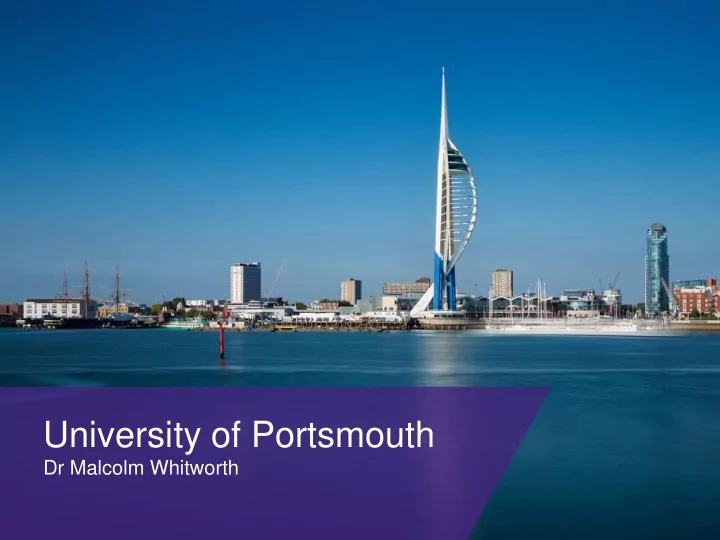

Click icon to add picture University of Portsmouth Dr Malcolm Whitworth
Location • Portsmouth is located on south coast of UK, about 90 minutes train journey from London. Project funded by the Erasmus+ programme of the European Union
Portsmouth the Island City Located in Portsmouth, a vibrant city on the coast of southern England. 90 minutes by train from central London and airports. International ferry port and gateway to Europe.
Summary • Population of 25,000 undergraduate and postgraduate students • Supported by 2,500 full time academic and support staff. • Undergraduate, MSc, MRes and PhD programmes • More than 4,000 international and EU students from almost 150 countries. • Gold rated teaching quality (TEF) and areas of research excellence (REF)
School of Earth and Environmental Sciences 30 Academic Staff 13 Support Staff 600 Undergraduates 120 Postgraduates (MSc) 40 Research Students (PhD) School is based in Burnaby Building and has a friendly, supportive and vibrant atmosphere.
Postgraduate degrees Department of Geography MSc Geographical Information Systems (GIS) MSc Coastal and Marine Resource Management School of Earth and Environmental Sciences MSc Engineering Geology MSc Geological and Environmental Hazards MSc Environmental Geology and Contamination MSc Crisis and Disaster Management Project funded by the Erasmus+ programme of the European Union
Teaching term structure • MSc course is a full time 12 month degree beginning with induction in September through to project submission the following September. 12 month full time degree Induction Term 1 Term 2 Project September Sept - Dec Jan - March Apr - Sept One week Fieldwork and exam Weekly lectures Weekly lectures induction period. Project and practicals for and practicals for program for preparation and data 12 week term. 12 week term. all students collection (May-Sept) Project funded by the Erasmus+ programme of the European Union
Course Accreditation • Our geoscience undergraduate and postgraduate courses are accredited. • Accrediting bodies include Geological Society of London and the Institution of Environmental Sciences . • Provides accelerated route to Chartered Geologist (CGeol), Chartered Scientist (CSci) or Chartered Environmental Scientist (CEnv) status. www.the-ies.org/ www.geolsoc.org.uk Project funded by the Erasmus+ programme of the European Union
Master’s of Research degrees • 200 students have so far graduated the MRes course • Excellent employment rate following graduation, with 33% of the graduates gaining a place on a PhD project. • The course is extremely popular with at least 50 MRes students currently registered across the Faculty of Science. Project funded by the Erasmus+ programme of the European Union
School of Earth and Environmental Sciences • School has an active research community of UK, EU and international PhD students. • School also offers a one year research degree termed Master’s of Research (MRes). Popular with those students wishing to pursue a research career. Standard one year Standard three or four PhD MRes year research degree. masters research degree. Project funded by the Erasmus+ programme of the European Union
Research degrees • PhD and MRes student training is supported by the The Graduate School who also provide information on our research degrees and how to apply: http://www.port.ac.uk/graduate-school/. Project funded by the Erasmus+ programme of the European Union
Research groups Crustal evolution research group has particular strength in the innovative use of accessory minerals to gain new insight into a range of tectonic processes. Ecotoxicology and Environmental Monitoring is a cross disciplinary group focuses on evaluation of impacts of a range of in aquatic systems. Rock Mechanics Research Group focuses on how rocks deform, under what conditions of pressure and temperature. Project funded by the Erasmus+ programme of the European Union
Research groups Biodiversity and Evolution is a cross disciplinary research group that has strengths in plant diversity and evolution together with studies of evolutionary processes over geological timescales. Centre for Applied Geoscience is a cross disciplinary research group that undertakes research and consultancy activities in the investigation and management of natural and man-made hazards. Geomatics and remote sensing group provide expertise in the application of remote sensing and GIS for environmental and natural hazard assessment. Project funded by the Erasmus+ programme of the European Union
Teaching and research Field courses laboratory facilities Project funded by the Erasmus+ programme of the European Union
State of the art teaching labs Rock Mechanics Laboratory (RML) provides detailed rock physics testing under a large variety of simulated conditions via the use of high-force uniaxial, triaxial and direct shear cells, with a full 12 channel acoustic emission suite and pore pressure control.
Mass Spectrometry and Laser Ablation Laboratory (MSLA) A state-of-the-art facility for trace element and isotopic analysis of natural and industrial materials. Specialising in the direct analysis of solid samples by laser ablation and ICP-MS.
Electron Microscopy and X-Ray Laboratory (EMX) A specialist facility for advanced imaging, chemical and mineralogical analysis of a wide range of materials using Scanning Electron Microscopes (SEMs) with Energy Dispersive Spectroscopy (EDS) and electron backscatter diffraction (EBSD), X-ray Diffraction (XRD) and X-ray Fluorescence (XRF).
Environmental Chemistry Laboratory (ECAL) Tests for a wide variety of trace elements, pollutants and much more. Routine applications include the analysis of soils, sediments and waters for metals, nutrients and chlorophyll. Equipment includes ICP- OES, Nutrient Analyser, GC-MS and LC-MS).
The Schools remote sensing facility includes dedicated computer laboratory, specialist software and several light weight autonomous drones for high resolution visible and infra red mapping and digital elevation model generation.
Imaging and Virtual Reality • School has invested heavily in the Virtual Reality and has a dedicated teaching and research facility. • Virtual Reality and Augmented Reality systems available. • University is leading an Erasmus+ project with 12 European collaborators on use of emerging technology for study of onshore and offshore natural hazards. Project funded by the Erasmus+ programme of the European Union
Contact Dr. Malcolm Whitworth School of Earth and Environmental Sciences University of Portsmouth Burnaby Road, Portsmouth. United Kingdom malcolm.whitworth@port.ac.uk http://www.port.ac.uk/sees/ 023 9284 2259 (office) Project funded by the Erasmus+ programme of the European Union
Recommend
More recommend